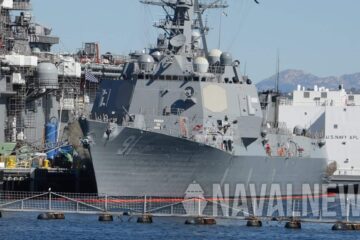NAVSEA press release
The DDG 51 Flight III upgrade is centered on the AN/SPY-6(V)1 Air and Missile Defense Radar and incorporates upgrades to the electrical power and cooling capacity plus additional associated changes to provide greatly enhanced warfighting capability to the fleet. The Flight III baseline begins with DDGs 125-126 and will continue with DDG 128 and follow on ships.
“Flight III ships will provide cutting edge Integrated Air and Missile Defense capability to include significantly greater detection range and tracking capacity. Launching the first Flight III ship, the future Jack H. Lucas, is another important step to delivering Flight III to the Navy”
DDG 51 Arleigh Burke-class Program Manager, Capt. Seth Miller.
The DDG 51 Arleigh Burke-class Guided Missile Destroyer (DDG 51) is a multi-mission guided missile destroyer designed to operate offensively and defensively, independently, or as units of Carrier Strike Groups, Expeditionary Strike Groups, and Surface Action Groups in multi-threat environments that include air, surface and subsurface threats. These ships will respond to Low Intensity Conflict/Coastal and Littoral Offshore Warfare scenarios, as well as open ocean conflict, providing or augmenting power projection, forward presence requirements and escort operations at sea. Flight III is the fourth Flight upgrade in the 30+ year history of the class, building on the proud legacy of Flight I, II and IIA ships before it.
HII is currently constructing four other DDG 51 class ships, including the future Frank E. Petersen Jr. (DDG 121) and Lenah Sutcliffe Higbee (DDG 123) in the Flight IIA configuration, and the future Ted Stevens (DDG 128) and Jeremiah Denton (DDG 129) as Flight III ships. There are a total of 20 DDG 51 class ships under contract at both new construction shipyards.
-End-
Naval News comments: About DDG 51 Flight III Destroyer

Flight III destroyers will have improved capability and capacity to perform Anti-Air Warfare and Ballistic Missile Defense in support of the Integrated Air and Missile Defense mission. This system delivers quick reaction time, high firepower, and increased electronic countermeasures capability for Anti-Air Warfare.
The Flight III design contains modifications from the earlier DDG 51 class, to enable the SPY-6 radar, in association with Aegis Baseline 10, which includes larger electronically scanned arrays and the power generation and cooling equipment required to operate the powerful new radar.






